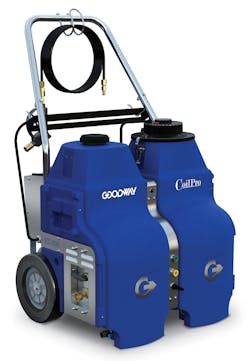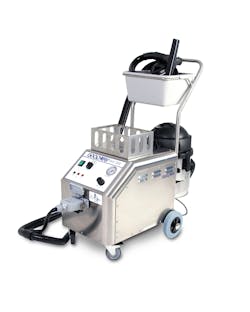Reopening Facilities: Tips and Tactics
As states begin reopening this month after social restrictions due to the Coronavirus, manufacturers may be unsure of where to start to get their facilities back up and running. The biggest factors are trying to manage equipment health and employee health as most state guidelines are still requiring sanitation and social distancing—but this can seem like an overwhelming task.
New Equipment Digest spoke with Goodway Technologies, a manufacturer of specialized industrial maintenance products, to gain some clarity on what steps need to be taken when reopening facilities and how to ensure employee health is not at risk.
NED: What are some basic steps manufacturers can take when reopening facilities?
Goodway: A complete review of your mechanical system health is the first step, including both visual inspection and analysis of critical metrics versus existing log data. Once mechanical systems have been reviewed, and the maintenance needs notes, thorough cleaning and sanitation are some of the best ways to take precautionary steps so that employees or anyone entering the facility feel safe and comfortable.
Deep cleaning means more than just wiping down main surfaces, although that is important. It also means getting into areas that might not have seen the light of day in years, as well as using proper cleaners and disinfectants. Always make sure to read the labeling and use the right products for the right scenarios.
For example, water-based disinfectants are excellent for many areas, but shouldn’t be used on sensitive electronics. For those situations, using an alcohol-based sanitizer is better due to its quick-drying properties. Here are some tips for conducting more effective cleaning:
- Get behind production and packaging machinery, tool chests, and storage areas as these areas can develop a buildup of fluids, garbage, and other debris.
- Clean the walls to remove residual dust and residue. Buildup on walls can reduce indoor air quality and impact the quality of products being produced.
- Make sure to clean the top of the lighting fixtures and remove residual dust.
- Drains are an area where bacteria can collect and should be included with a deep cleaning. The best solutions for cleaning drains are chemicals or using steam solutions.
- All surfaces (both top and underneath) in breakrooms or high-traffic areas should be cleaned.
- Any electronics that are generally not deeply cleaned or sanitized due to their sensitivity need special attention. These are best cleaned and sanitized using alcohol-based products, which are quick drying.
NED: For equipment that has been sitting for the past month or so—what are some maintenance measures manufacturers might want to consider regarding their equipment?
Goodway: Routine maintenance is always essential, but as manufacturers are getting back to business, it’s a good idea to run through your facility maintenance plan as you open up. This review should include a visual inspection of all systems and a review of baseline performance metrics.
Once the checks have been completed, make a list of items you will need. Shipping and product delays are common and so making sure you are building in proper planning times is critical. This will help make sure your time spent maintaining equipment is effective and productive.
Your equipment likely has a buildup of dirt and debris, which can negatively impact system performance. For example, HVAC or process cooling/heating systems that have remained dormant will most likely have dirt, debris, and sometimes growth, which will be spread as soon as the system comes back online. Performing basic maintenance tasks like filter replacement, coil cleaning, air duct cleaning, etc., should be conducted as they reopen.
More extensive systems that include chillers and cooling towers need to be especially careful, as the buildup of bacteria, like Legionella, could cause serious health risks. Complete cleaning and sanitation of cooling towers are recommended.
NED: Does all machinery need to be cleaned from top to bottom? How can manufacturers determine which parts of their facility need to be cleaned?
Goodway: A visual and systematic review of your machinery will tell you where to clean–and it may have been telling you for years! Now might be the ONLY time you have to deep clean and so manufacturers should take advantage of it. Practically speaking, though, and given the current environment, it is vital to thoroughly clean all of your high-touch areas, and environmental systems like HVAC equipment or process heating and cooling systems. Make sure you have a plan in place to continue with routine maintenance and cleaning.
NED: A big part of any building is its HVAC system since it can easily harbor and spread bacteria. How can manufacturers go about cleaning these systems?
Goodway: Maintaining good indoor air quality (IAQ) is vital to the health of employees and visitors. Visual inspection of the entire system should be completed. If you are operating chilled water systems with cooling towers, inspection and cleaning of cooling towers are very important to limit the spread of Legionella.
On-site staff should look at the significant heat transfer areas and visually inspect ductwork, coils, filters, air holders, blower wheels, and more. If you don’t have on-site staff, consult your HVAC professional. When it comes to the impact that a dirty HVAC system can have on indoor air quality, these are some of the areas where you should be paying the most attention.
- Coils: Coils should be cleaned regularly. Without proper cleaning, air conditioning coils in the air handlers can become a hot spot for mold and mildew growth. Both of these are culprits for poor indoor air quality. When systems have been off for a while, this can be a big challenge, especially in areas of high heat or humidity.
- Air Duct Cleaning: Since duct surfaces are typically hidden, they are easy to forget. This means they often accumulate dust, pollen, mold, and more, and this debris can collect on coils and recirculate into the air. There are several tools available for duct cleaning such as vacuums, agitation devices, and duct isolation equipment.
- Filters: Inspect and change all filters and consider moving to higher filtering levels (Merv 11 or more). Consult with your HVAC professional first, though, as increased filtering will impact airflow metrics and could negatively impact efficiency and lifespan of your equipment.
- Cooling Tower Cleaning: Cooling towers can also be a breeding ground for Legionella and other harmful bacteria. If a tower is infected with bacteria, it can spread to indoor air through ventilation and doorways/entrances and could impact the outdoor air quality in the surrounding area. Cleaning and sanitizing the cooling tower helps to prevent sediment, scale, and slime buildup, which can be cleaned with specialized cooling tower vacuums to avoid shutting down or draining the system.
- Cooling Tower Water Treatments: The outside air that is drawn into the tower can be contaminated with pollutants, which can increase bacterial growth. Chemical water treatments can protect against these issues and control the growth of harmful bacteria; however, they should be used in conjunction with mechanical cleaning methods.
NED: What are some products from Goodway Technologies that can help manufacturers ensure their facilities/equipment are sanitized?
Goodway: The CC-200 coil cleaning system is an all-in-one solution for cleaning a wide variety of coils in any facility. This portable product combines a pressurized water system for the wet cleaning of coils. Along with an integrated wet/dry vacuum for dry cleaning, and water pickup. They are designed for air handlers, PTAC units, refrigeration coils, and many more.
Goodway cooling tower cleaning systems help keep cooling towers clean and sanitized. The system includes the TowerVac cooling tower vacuum for removing solid deposits, and the TFC-200 tower fill cleaning system that removes scale and debris from fill and is also used for sanitizing towers with BIOSPRAY-TOWER EPA-registered disinfectant.
For sensitive machinery and electronics, using alcohol-based sanitizers and disinfectants are highly recommended to reduce any damage. BioSpray Systems and BioSpray D2 Sanitizer–Our BIOSPRAY Systems, in combination with D2 cleans and sanitizes food contact and non-food contact surfaces/disinfectant/tuberculocidal/virucidal*/fungicidal. It is an alcohol-based sanitizer that offers a quick drying time. It can be used for water-sensitive areas, such as conveyor belts, healthcare equipment, gyms, food packaging systems, and much more.
NED: Depending on the facilities’ size, sanitizing can seem like a daunting task. Are there any specific products from Goodway that can help larger facilities tackle this job more quickly? Conversely, are there specific products that are better suited for smaller facilities?
Goodway: We offer industrial dry steam cleaners that make the task of cleaning and sanitizing larger areas more manageable, such as the GVC-36000 heavy-duty industrial dry steam cleaner. It produces continuous steam at 17.5 gallons per hour and features both an in-operation refillable water tank and a continuous fill hose connection, so you don’t need to stop.
The GVC-1502-VAC dry steam cleaner can be used for smaller facilities while still offering power and versatility. It can be used in a variety of environments and is safe for a multitude of surfaces, including worktables, seats, carpets, desks, door handles, and more.













